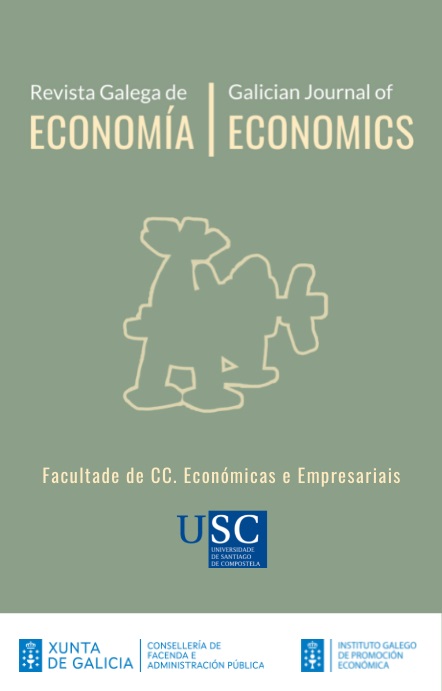Perdas de capital humano en Ucraína debido a crises demográficas, socioeconómicas e sociopolíticas, 1990-2019
Contido principal do artigo
Resumo
A prosperidade da economía do país só é posible coa acumulación continua de capital humano. O artigo analiza os factores que influíron na acumulación de capital humano en Ucraína durante a súa independencia. Descríbense as condicións iniciais que caracterizaron o desenvolvemento demográfico e socioeconómico de Ucraína no momento da súa independencia. Determínanse os criterios de influencia na toma de decisións dunha persoa para crear unha familia e conseguir un emprego, que no longo prazo marcan as tendencias na acumulación de capital humano no país. Revélanse as tendencias máis ameazantes da influencia da crise demográfica, socioeconómica e sociopolítica nos procesos de acumulación de capital humano en Ucraína.
Finalmente, analízanse os cambios na clasificación de Ucraína entre os países do mundo por indicadores demográficos e socioeconómicos durante o período 1990-2019.
Palabras chave
Detalles do artigo
Citas
All-Ukrainian Population Census. (2001). Retrieved from: http://2001.ukrcensus.gov.ua/
Borjas, G. J. (2005). The labor market impact of high-skill immigration. American Economic Review, 95(2), 56-60. DOI: https://doi.org/10.1257/000282805774670040
Bublyk, M., Udovychenko, T., & Medvid, R. (2019). Concept of smart specialization in the context of the development of Ukraine’s economy. Economics. Ecology. Socium, 3, 55-61. DOI: https://doi.org/10.31520/2616-7107/2019.3.2-6
Contact Ukraine. (August 16, 2016). Ukraine labor market updates 2016. (Message in a blog). Retrieved from: https://www.contactukraine.com/blog/ukraine-labor-market-updates-2016
Czapliński, P., & Dzhaman, V. (2019). Problems of the Ukrainian labor market. Journal of Geography, Politics and Society, 9(4), 24-34. DOI: https://doi.org/10.26881/jpgs.2019.4.03
Dluhopolskyi, O., Zatonatska, T., Lvova, I., & Klapkiv, Y. (2019). Regulations for returning labour migrants to Ukraine: international background and national limitations. Comparative Economic Research, 22(3), 45-64. DOI: http://doi.org/10.2478/cer-2019-0022
European Training Foundation. (2019). Youth transition to work in Ukraine. Turin, Italy: European Training Foundation. Retrieved from: https://www.etf.europa.eu/sites/default/files/2019-07/Youth%20transition%20Ukraine.pdf
Eurostat. (2020). Labour market, including labour force survey (LFS) – Overview. Luxembourg, Luxembourg: Eurostat. Retrieved from: https://ec.europa.eu/eurostat/web/labour-market/overview
Grishnova, O., & Kostenko, T. (2011). New approaches to motivating labor taking into account the system of life values of youth. Ukraine: Aspects of Labor, 7, 3-8.
International Labour Organization. (2011). Decent work country profile: Ukraine. Geneva, Switzerland: International Labour Organization-ILO. Retrieved from: http://www.oit.org/wcmsp5/groups/public/--dgreports/---integration/documents/publication/wcms_167363.pdf
International Organization for Migration. Mission in Ukraine. (2016a). Migration in Ukraine: Facts and figures. Kyiv, Ukraine: IOM Ukraine. Retrieved from: www.iom.org.ua/sites/default/files/ff_eng_10_10_press.pdf
International Organization for Migration. Mission in Ukraine. (2016b). Migration as an enabler of development in Ukraine. Kyiv, Ukraine: IOM Ukraine. Retrieved from: http://www.iom.org.ua/sites/default/files/iom_migration_as_an_enabler_of_development_in_ukraine.pdf
Kharlamova, G., Chala, N., Gumenna, O., & Osinchuk, T. (2020). The regional resources of ukraine and new opportunities for economic development until 2030. The Market for Ideas, 25. Retrieved from: http://www.themarketforideas.com/the-regional-resources-of-ukraine-and-new-opportunities-foreconomic-development-until-2030-a427/
Kolot, A., & Herasymenko, O. (2017). A deficit of decent work as a current trend in the development of social and labor sphere in Ukraine. Knowledge and Performance Management, 1(1), 5-18. DOI: http://dx.doi.org/10.21511/kpm.01(1).2017.01
Kolot, A. M. (2010). The social and labor issues: State relations, new challenges and trends: Monograph. K. Kyiv, Ukraine: Kyiv National Economic University.
Kupets, O. (2012). Characteristics and determinants of internal labor mobility in Ukraine. Report No. 68824-ECA. Washington DC, WA: World Bank. Retrieved from: https://openknowledge.worldbank.org/handle/10986/26804
Kupets, O., Vakhitov, V., & Babenko, S. (2013). Ukraine case study: Jobs and demographic change. The World Development Report 2013. Washington DC, WA: World Bank. Retrieved from: https://mtu.gov.ua/files/for_investors/Jobs%20And%20Demographic%20Change%20Ukraine%202013.pdf
Markina, I., Sharkova, A., & Barna, M. (2018). Entrepreneurship in the shadow economy: The case study of Russia and Ukraine. International Journal of Entrepreneurship, 22(3), 1-13. Retrieved from: https://www.abacademies.org/articles/entrepreneurship-in-the-shadow-economy-the-casestudy-of-russia-and-ukraine-7457.html
Ministry of Social Policy of Ukraine. (2020). Internally displaced persons. Kyiv, Ukraine: Ministry of Social Policy of Ukraine. Retrieved from: https://www.msp.gov.ua/en/
Mishchuk, H., & Grishnova, O. (2015). Empirical study of the comfort of living and working environment – Ukraine and Europe: Comparative assessment. Journal of International Studies, 8(1), 67-80. DOI: https://doi.org/10.14254/2071-8330.2015/8-1/6
Organisation for Economic Co-operation and Development. (2012). Ukraine sector competitiveness strategy. Competitiveness and private sector development. Paris, France: OECD. Retrieved from: https://www.oecd.org/countries/ukraine/ukrainesectorcompetitivenessstrategy.htm
Petrova, I., & Mosiychuk, T. (2016). Globalization impact on problems of innovation and economic security of Ukraine. European Journal of Economics and Management, 2(1), 130-135. Retrieved from: https://eujem.cz/wp-content/uploads/2016/eujem_2016_2_1/23.pdf
Ptoukha Institute for Demography and Social Studies of the National Academy of Sciences of Ukraine. (2020). Retrieved from: https://www.idss.org.ua/index_en
Refugees and Internally Displaced Persons. (2015). Retrieved from: https://www.ipu.org/about-ipu/structureand-governance/governing-council/committee-promote-respect-international-humanitarian-law/refugeesand-internally-displaced
Research & Branding Group. (2020). Retrieved from: http://rb.com.ua/en/
Scheve, K. F., & Slaughter, M. J. (2001). Labor-market competition and individual preferences over immigration policy. Review of Economics and Statistics, 83(1), 133-145. DOI: https://doi.org/10.1162/003465301750160108
State Statistics Service of Ukraine. (2020). Population and migration. Kyiv, Ukraine: State Statistics Service of Ukraine. Retrieved from: http://www.ukrstat.gov.ua/
Ukrainian Centre for Economic and Political Studies Named after Olexander Razumkov. (2019). The war in Donbas: Realities and prospects for settlement. National Security and Defence, 1-2(177-178). Retrieved from: http://razumkov.org.ua/uploads/journal/ukr/NSD177-178_2019_ukr.pdf
United Nations Development Programme in Ukraine. (2010). Poverty and social impact analysis of the economic crisis in Ukraine. Kyiv, Ukraine: UNDP Ukraine. Retrieved from: http://content-ext.undp.org/aplaws_publications/2819389/1958-UNDP-PSIA-Report-LR.pdf
United Nations Development Programme. (2014). Human development report 2014. Sustaining human progress: Reducing vulnerabilities and building resilience. New York, NY: UNDP Ukraine. Retrieved from: http://hdr.undp.org/sites/default/files/hdr14-report-en-1.pdf
World Bank. (2018). Moving for prosperity: Global migration and labor markets. Policy Research Report. Washington DC, WA: World Bank. DOI: https://doi.org/10.1596/978-1-4648-1281-1
World Data Atlas. (2020). Topics. Retrieved from: https://knoema.com/atlas/topics/
Zakharova, О. (2019). Specificity of knowledge management in the enterprise in dependence on the stage of the person’s life cycle. Journal of the Knowledge Economy, 10, 1447-1465. DOI: https://doi.org/10.1007/s13132-018-0550-0
Zakharova, О., & Kratt, O. (2014). Economic study and risk estime of the investment in the human capital. Economics & Sociology, 7(2), 94-108. DOI: https://doi.org/10.14254/2071-789X.2014/7-2/8







